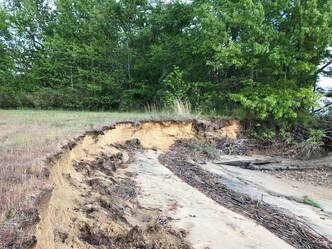Is a living shoreline right for me? An eroding shoreline on the James River. Photo by the James River Association. An eroding shoreline on the James River. Photo by the James River Association.
Living shorelines are nature-based approaches for shoreline protection and are the preferred stabilization method for tidal shorelines. In addition to stabilizing shorelines, they conserve and restore natural habitats and provide ecosystem services.
A living shoreline may be a good option if your shoreline is eroding or if your current shoreline structure is starting to fail. Site conditions will determine which type of shoreline stabilization approach is appropriate and these approaches vary in appearance and cost. Below are examples of living shorelines from our region. There are technical and financial assistance programs available to residents in the James River watershed to assist with the installation of living shorelines. You can Apply for Cost Share if you are in the Lower James Watershed. If you are not in the James River Watershed, check out other assistance programs available in Virginia. Waterfront Homeowners Fight Erosion with Living ShorelinesHomeowners along Virginia waterways show how living shorelines both effectively control erosion and beautify properties. These buffers of natural grasses absorb wave energy, filter pollution, and create wildlife habitat. As part of the Living Shoreline Collaborative, the Chesapeake Bay Foundation works to raise awareness about the many benefits of living shorelines for protecting waterfronts and connects homeowners with resources. The Elizabeth River Project supported homeowners in this video with installing living shorelines.
Example ProjectsCoir LogThese projects use a coconut fiber log (also called a coir log) that stabilizes the edge of the marsh as the plants grow; eventually the fiber log decomposes.
Oyster Castle SillOyster castles, which are one of many artificial oyster reef products on the market, provide stabilization and protection from wind and wave energy. Over time oysters will colonize the concrete oyster castles. Pictures were taken at low tide.
Stone SillStone sills typically use riprap (rock) to stabilize the project and provide protection from wind and wave energy.
BreakwaterOffshore breakwaters are considered a hybrid approach and are suited for high-energy shorelines where wind, waves, and boat traffic can impact shoreline conditions.
|
Living shorelines are not the only method of shoreline stabilization. This brochure by SAGE Coast depicts the spectrum of shoreline stabilization approaches. BenefitsLiving shorelines provide benefits to property owners, wetlands, waterways, and the surrounding communities. These benefits include:
|